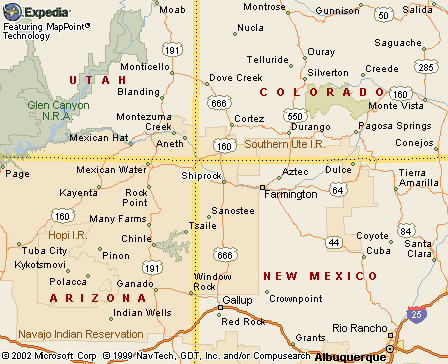|
|
Canku Ota |
|
|
(Many Paths) |
||
|
An Online Newsletter Celebrating Native America |
||
|
January 25, 2003 - Issue 79 |
||
|
|
||
|
Shoe Game Teaches About Animals, Fairness |
||
|
art: Navajo Children by Gladys
Carambella
|
 SHIPROCK,
NM - Wintertime, with its short days and long nights, is the time for
telling stories about animals and playing games like the Navajo Shoe
Game. SHIPROCK,
NM - Wintertime, with its short days and long nights, is the time for
telling stories about animals and playing games like the Navajo Shoe
Game. Bilingual classes from Central School District are teaching one another about the game. Ts Bit'Ai Middle School pupils shared their knowledge of the Shoe Game with younger pupils when they recently toured elementary schools in Shiprock. Ts Bit' Ai Middle School pupils performed a skit of the Shoe Game to explain a time in the Navajo historical period when the insects, bird and animal people emerged into the fourth world, where One Walking Giant roamed. Everyone feared and avoided the giant and he became very lonely. Meanwhile, First Man and Coyote talked about creating day and night. While Coyote wanted to throw a pebble into water to determine the fate of whether it would always be day or always be night; First Man wanted the night people and day people to play a game to decide the matter. "The game teaches the characteristics of the animals and really how cheating won't get you anywhere," said bilingual teacher Lula Begay of Ts Bit' Ai Middle School. The game is enhanced with a lot of songs about the animals who are taking part in the games, added Mamie Becenti, a bilingual teacher from Naschitti Elementary School. "The game brings out the true colors' of the animals," Becenti said, noting that the animals also learn about one another's strengths and weaknesses. The short songs are used to distract players on the other team. With the help of bluebirds, everyone was notified of the Shoe Game including One Walking Giant. Everyone gathered at Lukachukai and after Coyote helped the people start the game, they played on into the night. Night people and day people, one after the other, hid a yucca ball from one another in a pair of moccasins. When it appeared that the night people were going to win, Owl panicked and decided to cheat. He pretended to hide the ball but kept it in his hand. When the Giant stepped up to find the ball and missed, everyone laughed at him. Rat Woman saw this and whacked the Owl with the stick. As the day began to light up and the night people left, neither the day people nor the night people won the game. So today there is equal amounts of day and night and the Shoe Game is played during the winter months. Central Schools Shiprock Administration Office provided this article.
|
|
|
||
|
|
||
| Canku Ota is a free Newsletter celebrating Native America, its traditions and accomplishments . We do not provide subscriber or visitor names to anyone. Some articles presented in Canku Ota may contain copyright material. We have received appropriate permissions for republishing any articles. Material appearing here is distributed without profit or monetary gain to those who have expressed an interest. This is in accordance with Title 17 U.S.C. section 107. | ||
|
Canku Ota is a copyright © 2000, 2001, 2002, 2003 of Vicki Lockard and Paul Barry. |
||
 |
 |
|
|
The "Canku Ota - A Newsletter Celebrating Native America" web site and its design is the |
||
|
Copyright © 1999, 2000, 2001, 2002, 2003 of Paul C. Barry. |
||
|
All Rights Reserved. |
||
